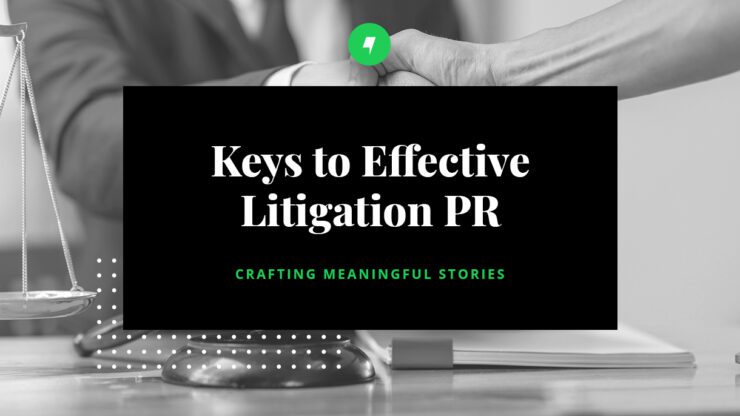For law firms, a key part of any comprehensive communications strategy involves crafting compelling narratives around case wins and active litigation. Often, lawyers are eager to tout important verdicts or settlements, but they don’t always have the time, experience or media relationships to successfully publicize their victories.
That’s where partnering with a professional public relations firm can make all the difference. A PR firm that represents law firms will work closely with attorneys to identify newsworthy cases and leverage their media contacts to tell stories that are in line with the overarching goals of the firm. Here, we look at some reasons, and effective tactics, for engaging in quality litigation PR.
Case Wins
When it comes to garnering media attention for legal victories, the most common obstacle we encounter is ensuring that the news is fresh enough to publish. Too often, lawyers will flag a decision or verdict a week or more after it was issued. News publications want to report information right away, and this kind of delay typically means that an important window for publicity has closed.
As PR professionals, we take a proactive approach to making sure that important wins don’t fall through the cracks. By maintaining regular touch points with key practice groups, we can build out a pipeline of pending cases to prepare for when a decision ultimately does come down. That may include drafting a formal press release with extensive case background, quotes and key passages from a court opinion. Or it could simply mean queuing up a few-sentence pitch to package and send to reporters along with copies of relevant case documents.
Regardless of the method, time is of the essence, and it’s important that reporters hear from us first. Working with attorneys in advance ensures that we have approved messaging and materials ready to go when the news breaks. The longer lead time also provides a runway to work through client permissions and anticipate any concerns that may arise down the road.
Of course, there will always be surprises, and not every case is going to be vigorously vetted ahead of time. In these instances, it’s important to proactively communicate to attorneys what materials we will need to conduct high-speed outreach on the fly. When flagging a case win, attorneys should be prepared to provide the following:
· Relevant case documents—including the operative complaint, key briefs and a copy of the decision or verdict form—as well as a case number and any necessary background information
· A short quote or statement on the ruling and its impact
· Availability for interviews with interested reporters
Sometimes, an attorney may have valid reasons for not wanting to comment publicly on a decision, particularly if further litigation is expected or if a ruling is expected to go up on appeal. In such cases, it can still be appropriate for a PR team to flag the news with reporters and provide a prepared or generic statement to journalists who reach out for comment.
Active Litigation
There are also numerous opportunities to garner attention for a case throughout the lifecycle of the litigation. These inflection points are varied and could include the filing of the complaint, interesting or dispositive motions, oral arguments or an appeal.
As with case wins, our job as PR professionals is to identify notable milestones in active cases and work with attorneys to construct a public narrative that complements their courtroom messaging and strategy. By properly framing the issues presented in the litigation, we can also position attorneys as subject matter experts and build the profiles as thought leaders in their practice areas.
Active cases, meanwhile, allow us to be more strategic with our media outreach. Because filing deadlines and argument dates are generally a matter of public record, we can often map out a gameplan weeks or even months in advance, with an eye toward future case developments. Even if certain milestones are not necessarily “newsworthy,” it may still be helpful to ping reporters as an FYI, to ensure the litigation is top-of-mind when we do seek coverage.
For particularly high-impact filings, we may consider contacting a trusted reporter to secure an embargoed article ahead of the filing. Once the reporter agrees to the terms of the embargo, they will receive a pre-filed copy of the documents but will wait to publish their story until an official version is submitted to the court. This tactic allows us to obtain high-quality, well-written coverage because the selected reporter has plenty of time to review the document, analyze its arguments and reach out with any questions for their reporting. Once the embargoed story goes live, other outlets will see the coverage and pile on with stories of their own.
Making the Leap
The needs—and appetite—for litigation PR vary from firm to firm, but working with an established agency can help attorneys unlock new opportunities to share their work with larger audiences. The increased media exposure, in turn, can enhance existing business development initiatives and bolster recruiting and retention efforts, making it a critical part of an integrated law firm communications strategy.
Posted In Public Relations
 Tom McParland
Tom McParland 